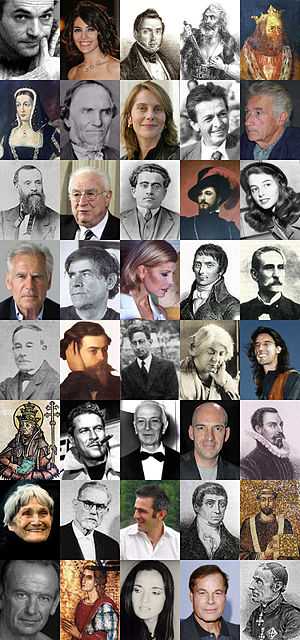Sardinian people
Sardinian people or Sardinians are the people from or with origins in Sardinia, a western Mediterranean island and autonomous region of Italy.
Origin and influences
Sardinians are the indigenous people hailing from the island of Sardinia,[2] which was populated in waves of emigration from the Paleolithic period until recent times.
Prehistory
Sardinia was first colonized in a stable manner during the Upper Paleolithic and the Mesolithic by people from the Iberian and the Italian peninsula. During the Neolithic period, people from Italy, Spain and the Aegean area settled in Sardinia. In the Eneolithic-Early Bronze age the "Beaker folk" from the Franco-Iberian area and from Central Europe[3] settled on the island, bringing new metallurgical techniques and ceramic styles and probably some kind of Indo-European speech.[4]
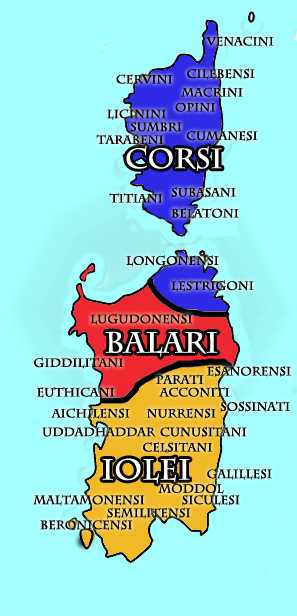
The Nuragic civilization arose during the Middle Bronze Age. At that time the island was divided into three or more major ethnic groups, the most important being the Ilienses, the Balares and the Corsi.[5] Nuragic Sardinians have been connected by some scholars to the Shardana, a tribe of the Sea Peoples, which appear several times in ancient Egyptian records,[6] but this hypothesis has been discredited by some other historians.
The language (or the languages) spoken in Sardinia during the Bronze Age is unknown . According to some reconstructions, the Proto-Sardinian language was akin to Basque with similarities with ancient Iberian, or even Etruscan. Other scholars believe that there were various linguistic areas (two or more), possibly pre-indoeuropeans and indoeuropeans.
Ancient history
In the 10th century BC, the Phoenicians founded cities and ports along the south-west coast, such as Caralis, Bithia, Sulki and Tharros.
The south of the island was partially conquered by the Carthaginians in the 6th century BC and was conquered by the Romans in the 3rd century BC. Sardinia, with the exception of the central mountainous area, was heavily "Latinized" during the Roman period, and the modern Sardinian language is considered one of the most conservative Romance languages[7][8][9]
Middle age
After the fall of the Western Roman Empire, Sardinia was ruled in rapid succession by the Vandals, the Byzantines, the Ostrogoths[10] and again by the Byzantines.
During the Middle Ages, the island was divided into four independent Kingdoms (Sardinian: Judicados; Italian: Giudicati); all of them, with the exception of that of Arborea, fell under the influence of the Genoese and Pisan maritime republics, as well as some noble families of the two cities, like the Doria and the Della Gherardesca. The Doria founded the cities of Alghero and Castelgenovese (today Castelsardo), while the Pisans founded Castel di Castro (today Cagliari); the famous count Ugolino della Gherardesca, quoted by Dante Alighieri in his Divine Comedy, favored the birth of the mining town of Villa di Chiesa (today Iglesias), which became an Italian medieval commune along with Sassari and Castel di Castro.
Following the Aragonese conquest of the Sardinian territories belonging to Pisa, which took place between 1323 and 1326, and then the long conflict between the Aragonese Kingdom and the Giudicato of Arborea (1353-1420), the newborn Kingdom of Sardinia became one of the states of the Crown of Aragon. The Aragonese repopulated the cities of Castel di Castro and Alghero with a number of Iberian colonists, mainly Catalans.[11][12] A local dialect of Catalan is still spoken by a minority of people in the city of Alghero.
Modern and contemporary history
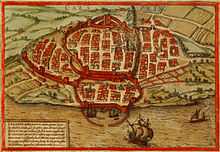
In the XVI and XVII century, the main Sardinian cities of Cagliari (the capital of the Kingdom), Alghero and Sassari appear well placed in the trades of the time. The cosmopolitan composition of its people provides evidence of it: the population was not only indigenous, but also hailing from Spain, Liguria, France and Corsica in particular.[13][14][15] Especially in Sassari and across the strip of territory that goes from Anglona to Gallura, the Corsicans became the majority of the population at least since the XV century.[15] This migration from the neighboring island, which is likely to have led to the birth of the Tuscan-sounding Sassarese and Gallurese dialects,[15] went on continuously until the XIX century.
The Spanish era ended in 1713, when the whole island was ceded to the Austrian House of Habsburg, followed with another cession in 1718 to the Dukes of Savoy, who assumed the title of "Kings of Sardinia". During this period, Ligurian colonists settled on the island of San Pietro and Sant'Antioco, in the south-west area of Sardinia, bringing with them a dialect called "Tabarchino", still widely spoken there. Then, the Piedmontese Kingdom of Sardinia annexed the whole Italian peninsula and Sicily in 1861 after the Risorgimento, becoming the Kingdom of Italy.

Since 1850, with the reorganization of the Sardinian mines, limited groups of specialised workers from Styria, Austria, followed by German miners from Freiburg began to settle temporarily in the Iglesiente, especially in the mining areas of Montevecchio, Guspini and Ingurtosu. Some Germans influenced building and toponym is still visible in this area.[16] However, the contemporaneous migration flow from the Italian peninsula towards the Sardinian mining areas was far more considerable and stable; these mainland miners came mostly from Lombardy, Piedmont, Tuscany and Romagna[17][18] According to an 1882 census realised by the French engineer Leon Goüine, in the south-western Sardinian mines worked 10.000 miners, one third of which coming from the Italian mainland;[19] most of the them settled in Iglesias and frazioni .
At the end of the 19th century, communities of fishermen from Sicily, Torre del Greco (Campania) and Ponza (Lazio) migrated on the east coasts of the island, in the towns of Arbatax/Tortolì, Siniscola and La Maddalena.
In the 20th century, a large immigration flow from the Italian peninsula during the Fascist period occurred, as a result of a government policy: a number of people hailing from Veneto but also from Marche, Abruzzo and Sicily came to Sardinia to populate the island, especially the new mining town of Carbonia and the villages of Mussolinia di Sardegna (now Arborea) and Fertilia; besides, after World War II, Istrian Italian refugees were relocated in the Nurra region, along the north-west coastline. Today Istriot, Venetian and Friulan are spoken by the elderly in Fertilia, Tanca Marchese and Arborea.[20] In the same period, few Italian Tunisian families settled in the sparsely populated area of Castiadas, east of Cagliari.[21]
Following the Italian economic miracle, a historic migratory movement from the inland to the coastal and urban areas of Cagliari, Sassari-Alghero-Porto Torres and Olbia, which today collect most of the people, took place.
Demographics
With a population density of 69/km2, slightly more than a third of the national average, Sardinia is the fourth least populated region in Italy. The population distribution is anomalous compared to that of other Italian regions lying on the sea. In fact, contrary to the general trend, urban settlement has not taken place primarily along the coast but towards the centre of the island. Historical reasons for this include repeated Saracen raids during the Middle Ages (making the coast unsafe), widespread pastoral activities inland, and the swampy nature of the coastal plains (reclaimed only in the 20th century). The situation has been reversed with the expansion of seaside tourism; today all Sardinia's major urban centres are located near the coasts, while the island's interior is very sparsely populated.
It is the Italian region with the lowest total fertility rate[22] (1.087 births per woman), and the region with the second-lowest birth rate;[23] However, the population has increased in recent years because of massive immigration, mainly from the Italian mainland, but also from Eastern Europe (esp. Romania), Africa and China.
As of 2013, there were 42.159 foreign national residents, forming 2,5% of the total population.[24]
Age expectancy and Longevity
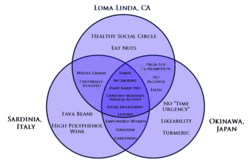
Average life expectancy is 81.9 years (84.9 for women[25] and 78.9 for men[25]).
Sardinia is the first discovered Blue Zone, a demographic and/or geographic area of the world where people live measurably longer lives.[26] Sardinians share with the Ryukyuans from Okinawa[27] (Japan) the highest rate of centenarians in the world (22 centenarians/100,000 inhabitants). The key factors of such a high contentration of centenarians are identified in the genetic of Sardinian population,[28] lifestyle such as diet and nutrition, and the social structure.[29]
Demographic indicators
- Birth Rate: 8.3 (per 1,000 inhabitants - 2005) [25]
- Fertility Rate: 1.07 (births per woman - 2005) [30]
- Mortality rate: 8.7 (per 1,000 inhabitants - 2005) [25]
- Infant mortality rate males: 4.6 (per 1,000 births- 2000) [31]
- Infant mortality rate females: 3.0 (per 1,000 births - 2000) [31]
- Marriage rate: 4.0 (per 1,000 inhabitants - 2005) [25]
- Suicide rate:11.4 (per 100,000 inhabitants)[32]
- Total literacy rate: 98.2%[33][34]
- Literacy rate under 65 years old: 99.5%[33][34]
Historical population
| Historical population | ||
|---|---|---|
| Year | Pop. | ±% |
| 1485 | 157,578 | — |
| 1603 | 266,676 | +69.2% |
| 1678 | 299,356 | +12.3% |
| 1688 | 229,532 | −23.3% |
| 1698 | 259,157 | +12.9% |
| 1728 | 311,902 | +20.4% |
| 1751 | 360,805 | +15.7% |
| 1771 | 360,785 | −0.0% |
| 1776 | 422,647 | +17.1% |
| 1781 | 431,897 | +2.2% |
| 1821 | 461,931 | +7.0% |
| 1824 | 469,831 | +1.7% |
| 1838 | 525,485 | +11.8% |
| 1844 | 544,253 | +3.6% |
| 1848 | 554,717 | +1.9% |
| 1857 | 573,243 | +3.3% |
| 1861 | 609,000 | +6.2% |
| 1871 | 636,000 | +4.4% |
| 1881 | 680,000 | +6.9% |
| 1901 | 796,000 | +17.1% |
| 1911 | 868,000 | +9.0% |
| 1921 | 885,000 | +2.0% |
| 1931 | 984,000 | +11.2% |
| 1936 | 1,034,000 | +5.1% |
| 1951 | 1,276,000 | +23.4% |
| 1961 | 1,419,000 | +11.2% |
| 1971 | 1,474,000 | +3.9% |
| 1981 | 1,594,000 | +8.1% |
| 1991 | 1,648,000 | +3.4% |
| 2001 | 1,632,000 | −1.0% |
| 2011 | 1,639,362 | +0.5% |
| Source: ISTAT 2011, - D.Angioni-S.Loi-G.Puggioni, La popolazione dei comuni sardi dal 1688 al 1991, CUEC, Cagliari, 1997 - F. Corridore, Storia documentata della popolazione di Sardegna, Carlo Clausen, Torino, 1902 | ||

Division by gender and age
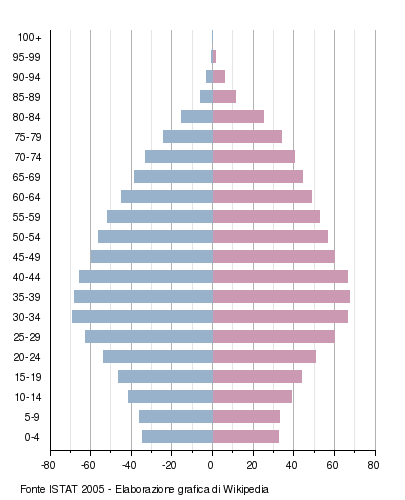
|
Total population by age

Geographical distribution
Most Sardinians are native to the island but a sizable percentage have settled outside Sardinia, it had been estimated that between 1955 and 1971 308,000 Sardinians have emigrated to the Italian mainland.[35] Sizable Sardinian communities are located in Piedmont, Liguria, Lombardy, Tuscany and Latium.
Sardinians and their descendants are also numerous in Germany, France, Belgium, Switzerland. In the Americas Sardinians migrated almost all in Southern part of the continent, especially in Argentina (between 1900 and 1913 about 12,000 Sardinians lived in Buenos Aires and neighbourhoods)[36] and Uruguay (in Montevideo in the 1870s lived 12,500 Sardinians) . Small communities with Sardinians ancestors, about 5000 people, are also found in Brazil (mostly in the cities of Belo Horizonte, Rio de Janeiro and São Paulo),[37] the UK and Australia.
The Region of Sardinia keeps a register of overseas Sardinians that managed to set up, in the Italian mainland and across the rest of the world, a number of cultural associations: these are meant to provide the people of Sardinian descent, or those with an interest on Sardinian culture, an opportunity to enjoy a wide range of activities. As of 2012, there are 145 clubs registered on it.[38]
| Sardinians residing in European countries 2008[39] | ||
|---|---|---|
| | 27,184 | |
| | 23,110 | |
| | 12,126 | |
| | 7,274 | |
| | 6,040 | |
| Others | 17,763 | |
| Total | 93,497 | |
Unlike the rest of Italian emigration, where migrants were mainly males, between 1953-1974 an equal number of females and males emigrated from Sardinia to the Italian mainland.
Languages
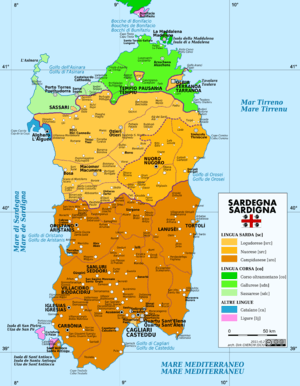
Alongside Italian (Italiano) that, once first introduced in the island by law on July 1760,[40][41] became the official language of the Piedmontese Kingdom at the expense of Spanish (Español), Sardinian (Sardu)[2][42] is the other most widely spoken language of the island; however, because of a rather rigid model of standardized education system that strongly discouraged the Sardinian youth from learning and speaking the language,[43] the people retaining Sardinian as their first language have gradually become a minority in their own homeland. As a result of that, both the Logudorese and Campidanese varieties of Sardinian have therefore been designated as definitely endangered by UNESCO.[44] The other languages spoken on Sardinia, all also endangered but with much fewer speakers than Sardinian, developed after the settlement of certain communities in different regions of the island over recent centuries; these include Sassarese (Sassaresu),[45] Gallurese (Gadduresu),[46] Algherese Catalan (Alguerés),[47] and Tabarchino (Tabarchin).[48]
Religion
The vast majority of the Sardinians is baptized as Roman Catholic. Our Lady of Bonaria is the Patroness Saint of Sardinia.
Notable Sardinians
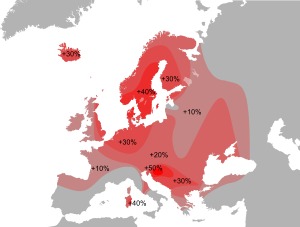
Genetic peculiarities of the population
Sardinians, although part of the European gene pool, differ from other Europeans because of particular phenomena that are often found in isolated populations, such as the founder effect and the genetic drift. The data seem to suggest that the current population is derived in large part from the Stone age settlers, with some other minor contributions in the Chalcolithic and the early Bronze age; very scarce, in terms of gene flow, appears instead the contribution of the historical colonizers.[49]
Recent comparisons between the Sardinians' genome and that of some individuals from the Neolithic and the early Chalcolithic, who lived in the Alpine (Oetzi), German, Swedish and Hungarian regions, showed considerable similarities between the two populations, while at the same time consistent differences between the prehistoric samples and the present inhabitants of the same geographical areas were noted.[50] From this it can be deduced that, while central and northern Europe have undergone significant demographic changes due to post-Neolithic migrations, presumably from the eastern periphery of Europe (Pontic-Caspian steppe), Southern Europe and Sardinia in particular were affected less; Sardinians and Basques appear to be the populations that have best preserved the Neolithic legacy of Western Europe.[50]
However, Sardinians as a whole are not a homogeneous population genetically wise: some studies have found micro-differences between the various regions of the island;[51] in this regard, the mountainous region of Ogliastra is more distant from the rest of Europe than other Sardinian subregions located in the plains and in the coastal areas.[52]
Gallery
Sardinian folk costumes and traditional masks:
-
.jpg)
Urthos mask of Fonni
-

Costumes from Maracalagonis
-
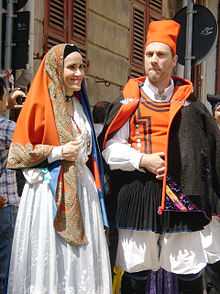
Costumes from Cagliari
-
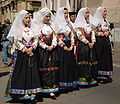
Costumes from Busachi
-
Costumes from Olbia
-

Costume from Sennori
-
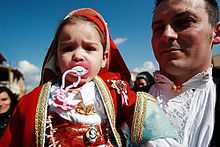
Costume from Oristano
-

Daily traditional costume from Dorgali
-
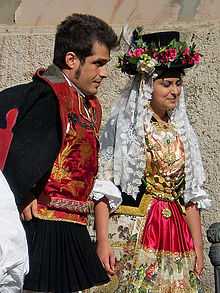
Folk costumes from Quartu Sant'Elena
-

Costumes from Selargius
-
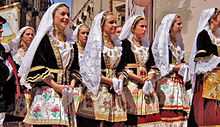
Women dressed in traditional Sardinian costumes (Selargius)
-

Costumes from Settimo San Pietro
-

Costume from Dolianova
-

Costume from Nuragus
-

Knights from Teulada
-

Traditional costume from Laconi
-

Costume from Tonara
-
.jpg)
Costumes from Fonni
-

A Mamuthone and an Issohadore, traditional carnival costumes from Mamoiada
-

Sardinian knights on Sa Sartiglia day (Oristano).
-
.jpg)
People in traditional dress (Busachi)
-

Costume from Orgosolo
-

Sardinian men and children in traditional dress at the Sagra del Redentore (Nuoro)
-
Children from Ovodda in traditional dress
-

An Issohadore, typical mask of the Sardinian carnival (Mamoiada)
-

A Mamuthone, another typical mask of the Sardinian carnival (Mamoiada)
-

Boe and Merdule (Ottana)
-

Mask of Sartiglia
-

Sardinians in traditional dress (Orgosolo)
-

Costume from Atzara
-
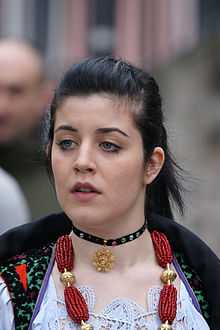
Costume from Oliena
-
Costume from Orune
-

Costume from Ittiri
-

Costume from Sassari
-

Sardinian man in traditional dress playing the Launeddas
-

Costume from Cossoine
-

Costume from Isili
See also
| Wikimedia Commons has media related to People of Sardinia. |
- Sardinia
- List of Sardinians
- Nuragic civilization
- List of Nuragic tribes
- History of Sardinia
- Sardinian language
- Sassarese
- Gallurese
- Algherese
- Corsican people
- Italian people
- Catalan people
References
- Casula, Francesco Cesare (1994). La Storia di Sardegna. Sassari: Carlo Delfino Editore.
- Brigaglia, Manlio; Giuseppina Fois; Laura Galoppini; Attilio Mastino; Antonello Mattone; Guido Melis; Piero Sanna; Giuseppe Tanda (1995). Storia della Sardegna. Sassari: Soter Editore.
- Ugas, Giovanni (2006). L'Alba dei Nuraghi. Cagliari: Fabula Editore. ISBN 978-88-89661-00-0.
Notes
- ↑ Statistiche demografiche ISTAT
- ↑ 2.0 2.1 Sardinians - World Directory of Minorities
- ↑ Manlio Brigaglia - Storia della Sardegna , pg. 48-49-50
- ↑ Giovanni Ugas - L'alba dei Nuraghi , pg.22-23-24
- ↑ Giovanni Ugas - L'alba dei Nuraghi, p. 241
- ↑ SardiniaPoint.it - Interview with Giovanni Ugas, archaeologist and professor of the University of Cagliari (Italian)
- ↑ Contini & Tuttle, 1982: 171; Blasco Ferrer, 1989: 14.
- ↑ Story of Language, Mario Pei, 1949
- ↑ Romance Languages: A Historical Introduction, Cambridge University Press
- ↑ Francesco Cesare Casula - La Storia di Sardegna, pg.141
- ↑ Manlio Brigaglia - Storia della Sardegna , pg.158
- ↑ Minority Rights Group International - Sardinians
- ↑ Stranieri nella Cagliari del XVI e XVII secolo da “Los Otros: genti, culture e religioni diverse nella Sardegna spagnola”, Cagliari, 23 aprile 2004.
- ↑ Antonio Budruni, Da vila a ciutat: aspetti di vita sociale in Alghero, nei secoli XVI e XVII
- ↑ 15.0 15.1 15.2 Carlo Maxia, Studi Sardo-Corsi, Dialettologia e storia della lingua fra le due isole
- ↑ ^ Stefano Musso, op. cit., p.314
- ↑ Stefano Musso, Tra fabbrica e società: mondi operai nell'Italia del Novecento, Volume 33, p.316
- ↑ Quando i bergamaschi occuparono le case
- ↑ Il progresso sociale della Sardegna e lo sfruttamento industriale delle miniere - Sardegnaminiere.it
- ↑ Veneti nel Mondo (Venetians in the World) - Anno III - numero 1 - Gennaio 1999 (Italian)
- ↑ E al ritorno conquistarono le terre abbandonate - La Nuova Sardegna
- ↑ ISTAT Numero medio di figli per donna per regione 2002-2005
- ↑ ISTAT Tassi generici di natalità, mortalità e nuzialità per regione 2002-2005
- ↑ Rapporto Istat - La popolazione straniera residente in Italia al 31º dicembre 2013
- ↑ 25.0 25.1 25.2 25.3 25.4 ISTAT
- ↑ Sardinia, Italy - Blue Zones
- ↑ Okinawa Exploration Backgrounds - Blue Zones
- ↑ Sardinia Exploration Backgrounds - Blue Zones
- ↑ Susan Pinker: why face-to-face contact matters in our digital age - The Guardian
- ↑ ISTAT Numero medio di figli per donna per regione 2002-2005
- ↑ 31.0 31.1 Ministero della Salute Speranza di vita e mortalità
- ↑ La mortalità per suicidio in Italia
- ↑ 33.0 33.1 Analfabetismo Italia - Censimento 2001
- ↑ 34.0 34.1 Sardegna Statistiche: Analfabeti
- ↑ Giuseppe Sanna - L'emigrazione della Sardegna (Emigration of Sardinia) (Italian)
- ↑ L'emigrazione sarda tra la fine dell' 800 e i primi del 900
- ↑ Il messagero sardo - Una piccola ma attiva colonia di sardi vive nello stato di Bahia (Italian)
- ↑
- ↑ Museo Nazionale Emigrazione Italiana - 25-03-2012
- ↑ Roberto Bolognesi, The phonology of Campidanian Sardinian : a unitary account of a self-organizing structure, The Hague : Holland Academic Graphics
- ↑ Amos Cardia, S'italianu in Sardìnnia, Iskra
- ↑ Sardinian is generally considered to be the most conservative Romance language, and was also the first language to split off genetically from the rest of the others, possibly as early as the first century BC. Most of the academic community usually subdivides Sardinian into two groups: the first one would be Logudorese (Sardu logudoresu) and the second one would be Campidanese (Sardu campidanesu).
- ↑ Lavinio, 1975, 2003
- ↑ UNESCO Interactive Atlas of the World’s Languages in Danger
- ↑ It's a language born as a lingua franca of Tuscan-Corsican origin, with minor Ligurian, Catalan and Spanish influences and major Logudorese Sardinian influence.
- ↑ It's a Corsican dialect with Logudorese Sardinian influence.
- ↑ It's a Catalan dialect spoken in Alghero by the time Catalan invaders repopulated the town and expelled the indigenous population.
- ↑ It's a Ligurian dialect spoken in Carloforte and Calasetta.
- ↑ Franco Germanà, L'uomo in Sardegna dal paleolitico all'età nuragica p.202-206
- ↑ 50.0 50.1 Genome flux and stasis in a five millennium transect of European prehistory
- ↑ High Differentiation among Eight Villages in a Secluded Area of Sardinia Revealed by Genome-Wide High Density SNPs Analysis
- ↑ Genome-wide scan with nearly 700 000 SNPs in two Sardinian sub-populations suggests some regions as candidate targets for positive selection
| ||||||||||||||||||||||||
